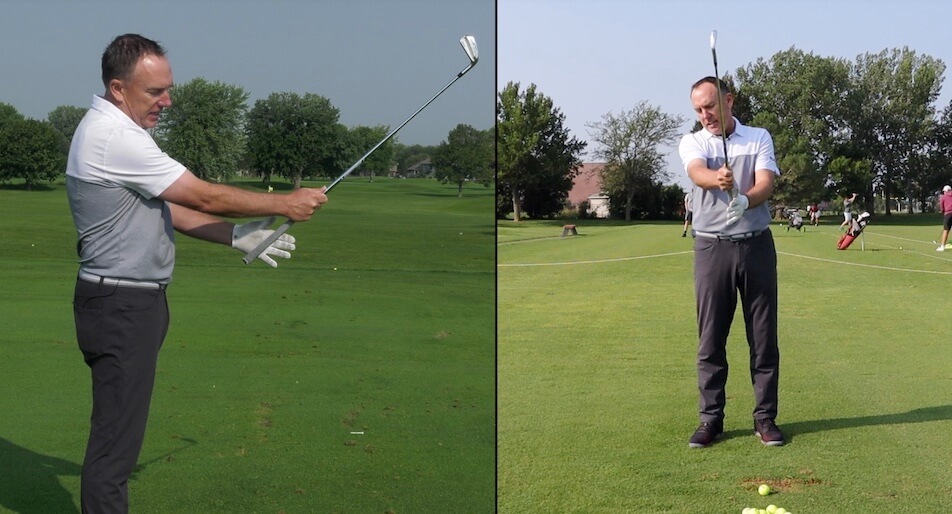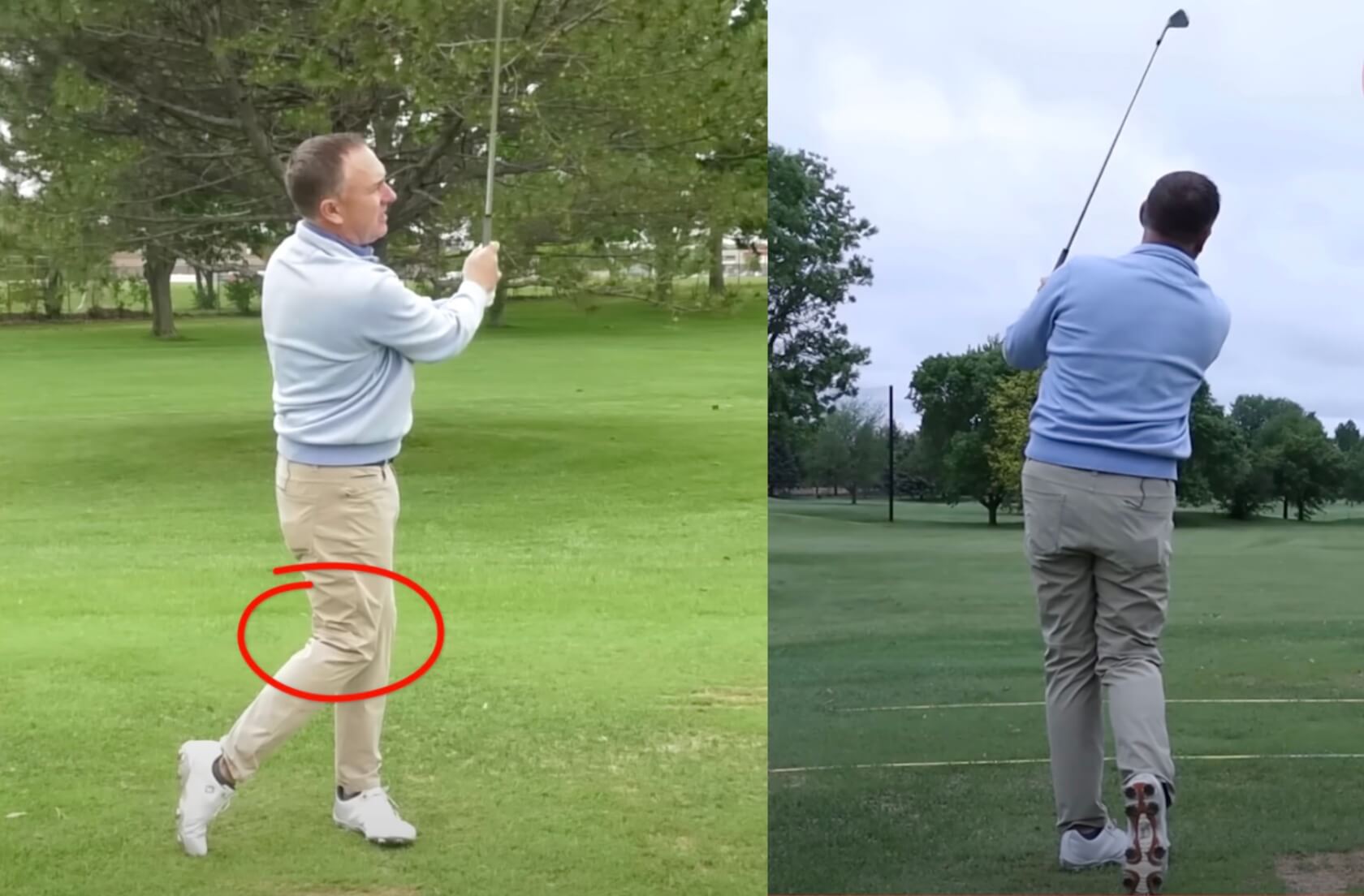5 Key Elements of the VLS Golf Swing for Seniors
Looking for a Quick Introduction to the VLS Golf Swing? These are the 5 Essential Tips Every Senior Golfer Should Know.
If you’re a senior golfer who’s new to the game of golf, you’ve got to get familiar with the VLS golf swing.
Really, anyone can benefit from learning this method. I developed the Vertical Line Swing (VLS) to help casual golfers—especially senior golfers—find more success and more fun on the golf course.
This is a swing technique that taps into the natural abilities of the everyday golfer. And that’s actually a pretty unusual approach.
See, traditional golf instruction focuses on emulating the approach of professional golfers. Sounds logical, but the fact is, most amateur golfers don’t have the strength and flexibility of a world-class player. They also can’t dedicate their lives to perfecting their swing.
It’s no wonder the majority of golfers hit a wall when they use traditional advice to improve their game. It’s even less of a surprise that folks who start golfing in their retirement years get off to a discouraging start.
Most of the tips you find tell you to rotate deep and swing hard. They demand a level of flexibility and balance that most folks over forty just don’t have. Not only is it difficult for the average golfer to execute these tips, many find that the attempt makes their contact and distance worse.
If you’re a senior golfer who’s new to the game and already feeling frustrated by slow or non-existent progress, I highly recommend checking out the Vertical Line Swing System.
But for now, I’ll offer you a simple introduction: five key concepts from the VLS golf swing that are absolutely essential for senior golfers…
…plus a super easy drill that ties them all together.
Let’s get started.
Tip #5: The VLS Golf Swing Grip
The way you hold the club influences the way you swing the club. For the VLS golf swing, we want to make sure two important things are happening in your grip.
First, you want to hold the club more in your fingers than in your palm. Gripping the handle in your palm causes you to lose leverage. It’s harder to hinge your wrist, you lose power, and you struggle to square the clubface.
In order to find that fingers-only grip:
- Hold the club out in front of you at a 45-degree angle.
- Position the handle in your lead hand so it runs from the pad at the base of your little finger to the middle knuckle of your index finger.
- Close your fingers around the handle and add your trail hand as you normally would.

The second thing to look out for is a strong grip. And what does that mean?
If you look at your lead hand when you grip your golf club, does your hand look like it’s rotated over the handle like you’re revving a Harley? Do you see two or more knuckles on your lead hand?
If the answer is yes, you’ve got a strong grip.
If your lead hand rotates under the handle and you don’t see any knuckles, you’ve got a weak grip. With a weak grip, you have a high risk of holding the club in your palm, opening the clubface, and hitting a slice. It may even cause soreness in your wrists, elbows, and shoulders.
Grip the club so you can see two to three knuckles on your lead hand. That’s the sweet spot for a senior golfer.
Tip #4 Setup
There are actually several adjustments senior golfers can make in their golf setup to drastically improve their contact and distance. For full instructions on this, you can check out my book, The Bad Lie. For now, let’s talk about the two most crucial aspects of your setup.
Ball Position
For iron shots, the ball should be in the center of your stance. You can try eyeballing this, but I recommend that newbies find the sweet spot this way:
- Stand with your feet together and the ball positioned in the center of your stance.
- Step your lead foot towards the target.
- Step your trail foot an equal distance away from the target.
It probably goes without saying, but you want these two equidistant steps to add up to the stance width that’s most comfortable for you. (Little tip: don’t hesitate to widen your stance for stability if you need to.)
Ball position matters because when we hit our irons, we want to make contact with the ball when the clubhead is traveling at a downward angle. We can only do that if the ball is positioned at the low point of the swing.
And the low point of a well-executed swing lands at about the center of your stance.
If you keep hitting the turf too early in your iron shots, you’ve probably got the ball too far forward in your stance.
Pressure
The second thing you want to look out for in your setup is pressure distribution. You want to feel about 60% of your pressure (or body weight) in your lead foot and 40% in your trail foot.
Now, this seems like a minor detail, but it’s a key concept in the VLS golf swing. It’s one of the best tips I could possibly give you for generating clubhead speed, picking up yards, and ensuring you make contact at the right angle.
You’ll find out why when we get to tip number two. But first, let’s move on to number three.
Tip #3: Backswing Strategy
Now we’re getting into the golf swing, and this is where things start to fall apart for a lot of golfers. If you’ve been looking for tips on improving your shots, you’ve probably discovered that traditional instruction asks you to track a lot of details in the course of a split-second motion.
So let’s keep it simple, shall we? I’m only going to ask you to pay attention to the logo on your golf glove.
That’s right. That’s it. Keep an eye on that logo, making sure it keeps pointing toward the target as it moves away from the golf ball. If your logo is looking at the target, you know your clubhead is at the right angle to deliver a square face at impact.
If, however, your logo rotates skyward, that means you’re opening the clubhead and heading for disaster.
Tip #2: Pressure Shift
This might be the golf tip I share the most. It’s a game-changer for any golfer, but it’s especially transformative for the senior golfer who’s been struggling to pick up swing speed with deep rotation and raw power.
Remember that 60/40 pressure split we set up in tip number four? Now you’re going to pay that off.
Early in the backswing, let the majority of your weight shift to your trail foot. Then, as you swing down and through, shift the pressure back into your lead foot.
This is such an overlooked concept in the game of golf, never mind the fact that this kind of weight transfer is a power-building strategy in every sport. Pitchers use it, tennis players use it, and senior golfers should always use it as a way to ramp up speed without painful rotation.
And this pressure shift doesn’t just help you increase your distance. It also improves your contact. By transferring weight back to your lead foot on the downswing, you ensure the low point of your swing happens at the correct spot.
A surprising number of amateur golfers keep their weight on the trail foot as they swing down and through. This moves the low point further back in their stance and they end up topping the golf ball.
So make sure you master this move. It’ll even help you execute my number one VLS golf swing tip for senior golfers.
Tip #1: Finish Position
You know what great follow-through looks like when it comes to sports. You can picture it. It’s what makes a pass from a great quarterback so smooth and powerful. And it’s why your favorite golfer looks so controlled in their swing even as they launch an absolute rocket off the tee.
So how do you create that kind of follow-through? It’s easier than you might guess.
When you finish your swing, get your knees touching and your weight on the lead foot to the point that your trail heel actually comes off the ground.

That’s all you have to think about. If you swing through with the goal of ending in that position, you’re going to find that smooth, powerful motion naturally.
Now, I’ve just given you five tips, which is probably about four more than the average golfer can focus on at once. Fortunately, I have a drill that’s going to get out of your head and into your body.
The Right Left Drill
You can run this drill on the driving range or even use it as a pre-shot routine. It works like this:
- Take your setup without a golf ball. Make sure:
- Your grip is strong.
- You’re gripping the club in your fingers.
- About 60% of your weight is on your lead foot.
- Take several practice swings in a continuous motion, saying “right” as you shift pressure to your right foot on the backswing and “left” as you shift pressure to your left foot on the downswing.
- Do that three times, then step up to the golf ball and take a shot, still thinking “right, left” as you swing.
Of course, if you’re a left-handed golfer, this would actually be the “Left Right Drill” for you.
So how does this routine help you master the essential concepts of the VLS golf swing?
The Right Left Drill helps you find the tempo of your swing, tap into that all-important weight transfer, and discover a smooth, natural swing motion. Along with a solid setup and a great finish, those accomplishments are the key to finding more speed and accuracy in your swing.
Recap: 5 Key Elements of the VLS Golf Swing
The next time you’re out on the course, think about incorporating these five concepts:
- Hold the club in the fingers of your lead hand and make sure you have a strong grip (you should see two to three knuckles on your lead hand).
- Nail your setup with proper ball position (center of your stance for irons) and 60% of your weight in your lead foot.
- On the backswing, keep the logo of your golf club pointing towards the target.
- Let your weight shift into your trail foot as you swing back and into your lead foot as you swing down and through.
- Finish with your knees touching, all your weight on the lead foot, and your trail heel lifted off the ground.
If you start to overthink it, try the Right Left Drill above to loosen up.
Are You Ready to Play Your Best Round?
Bottom line: if you’re new to golf, don’t get discouraged by complicated swing tips that seem impossible to execute. My general rule is that if you’re physically incapable of following a golf tip, then it’s not your golf tip.
The entire principle behind the Vertical Line Swing System is that everyone can enjoy the satisfaction of bettering themselves and their game. You just need advice that was meant for you.
That’s why I encourage you to check out the VLS System or join us in the comments here to ask any questions you have about playing the game as a senior golfer.
You can also find more senior-specific instruction and products at vlsgolf.com. Check it out! We’ll be happy to have you in our community.
 |
|
